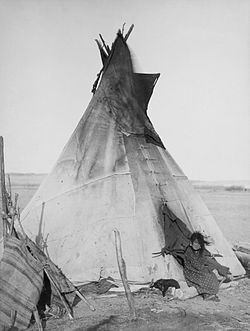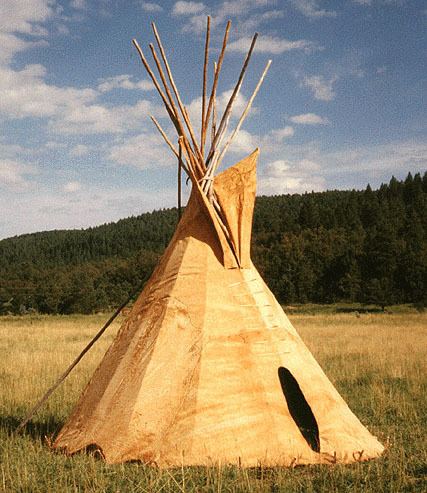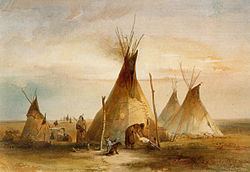 | ||
Renato doko tipi official video hd
A tipi (also tepee or teepee) is a cone-shaped tent, traditionally made of animal skins upon wooden poles. A tipi is distinguished from other conical tents by the smoke flaps at the top of the structure. Historically, the tipi was used by Indigenous people of the Plains in the Great Plains and Canadian Prairies of North America, as well as by indigenous peoples of northern Europe and Asia under other names. Tipi lodges are still in use by these peoples, though now primarily for ceremonial purposes.
Contents
- Renato doko tipi official video hd
- Nomadics tipi makers teepee setup demonstration
- Etymology and nomenclature
- Structure
- Decoration
- References

Tipis are stereotypically and incorrectly associated with all Native Americans in the United States and Aboriginal people in Canada, despite their usage being unique to the peoples of the Plains. Native American tribes and First Nation band governments from other regions have used other types of dwellings. The tipi is durable, provides warmth and comfort in winter, is cool in the heat of summer, and is dry during heavy rains. Tipis can be disassembled and packed away quickly when people need to relocate and can be reconstructed quickly upon settling in a new area. Historically, this portability was important to Plains Indians with their at-times nomadic lifestyle.

Nomadics tipi makers teepee setup demonstration
Etymology and nomenclature

The word tipi comes into English from the Lakota language. The Lakota word thípi [ˈtʰipi] means "a dwelling" or "they dwell", from the verb thí, meaning "to dwell".
The wigwam or "wickiup", a dome-shaped shelter typically made of bark layered on a pole-structure, was also used by various tribes, especially for hunting camps. The term wigwam has often been incorrectly used to refer to a conical skin tipi.
Structure

A typical family tipi is a conical, portable structure with two adjustable smoke flaps, multiple poles (historically from 12 to 25 feet long) called lodge poles. Lewis H. Morgan noted that,

The frame consists of thirteen poles from fifteen to eighteen feet in length, which, after being tied together at the small ends, are raised upright with a twist so as to cross the poles above the fastening. They are then drawn apart at the large ends and adjusted upon the ground in the rim of a circle usually ten feet in diameter. A number of untanned and tanned buffalo skins, stitched together in a form adjustable to the frame, are drawn around it and lashed together, as shown in the figure. The lower edges are secured to the ground with tent-pins. At the top there is an extra skin adjusted as a collar, so as to be open on the windward side to facilitate the exit of the smoke. A low opening is left for a doorway, which is covered with an extra skin used as a drop. The fire-pit and arrangements for beds are the same as in the Ojibwa lodge, grass being used in the place of spruce or hemlock twigs.
Lodgepole pine is the preferred wood in the Northern and Central Plains and red cedar in the Southern Plains. Tipis have a detachable cover over the structure. The cover has historically been made of buffalo hide, an optional skin or cloth lining, and a canvas or bison calf skin door. Modern lodges are more often made of canvas.
Ropes (historically raw hide) and wooden pegs are required to bind the poles, close the cover, attach the lining and door, and anchor the resulting structure to the ground. Tipis are distinguished from other tents by two crucial elements: the opening at the top and the smoke flaps, which allow the dweller to heat themselves and cook with an open fire; and the lining that is primarily used in the winter, which insulates. Tipis were designed to be easily set up or taken down to allow camps to be moved to follow game migrations, especially the bison. When dismantled the tipi poles were used to construct a dog- or later horse-pulled travois on which additional poles and tipi cover were placed.
Tipi covers are made by sewing together strips of canvas or tanned hide and cutting out a semicircular shape from the resulting surface. Trimming this shape yields a door and the smoke flaps that allow the dwellers to control the chimney effect to expel smoke from their fires. Old style traditional linings were hides, blankets, and rectangular pieces of cloth hanging about four to five feet above the ground tied to the poles or a rope.
Decoration
Historically, most tipis in a village would not be painted. Painted tipis often depicted note-worthy historical battles and often featured geometric portrayals of celestial bodies and animal designs. Sometimes tipis have been painted to depict personal experiences, such as war, hunting, a dream or vision. When depicting visions, "ceremonies and prayers were first offered, and then the dreamer recounted his dream to the priests and wise men of the community. Those known to be skilled painters were consulted, and the new design was made to fit anonymously within the traditional framework of the tribe's painted tipis."
